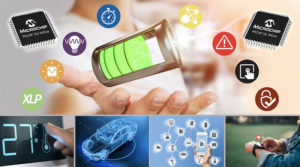System developers of battery-powered and other power-conscious designs — with and without LCD displays — can now easily add an array of innovative features using a new line of PIC eXtreme Low Power (XLP) microcontrollers (MCUs) from Microchip Technology Inc.
 Packed with 14 types of core independent peripherals (CIPs) that operate outside the central processing unit (CPU) for power savings, the PIC24F GU and GL families of MCUs feature the CIP called LCD with autonomous animation.
Packed with 14 types of core independent peripherals (CIPs) that operate outside the central processing unit (CPU) for power savings, the PIC24F GU and GL families of MCUs feature the CIP called LCD with autonomous animation.
Most display applications involve a few common animations, such as periodically alternating between displays and blinking of pixels to indicate operation. By using the integrated LCD driver with autonomous animation, developers can offload most of these simple animation routines from the CPU, allowing animation even in doze, idle, or sleep modes for optimal power savings.
To assist in quickly designing such display interfaces, the new MCUs come with MPLAB Code Configurator (MCC) support. This graphical programming environment with LCD display designer helps eliminate the meticulous and time-consuming task of mapping the pins and segments.
“The latest family of PIC MCUs adds new hardware features that improve low-power performance, code protection and reliable operation in applications across multiple segments,” said Joe Thomsen, VP of Microchip’s MCU16 business unit. “This scalable family of devices enables applications from cloud-connected low-power IoT nodes and sensor systems to automotive, consumer and industrial automation applications and helps developers easily add displays, robustness, and security to their designs.”
The new MCU families are also designed to make it easy to increase the security of an application, whether it is connected to the Internet or a standalone system. Microchip’s CodeGuard security Flash protection enables segmenting memory into boot and general segments to implement memory access restrictions. The Flash memory is configurable as one-time programmable (OTP) via Microchip’s In-Circuit Serial Programming (ICSP) write inhibit feature that disables any further modification of the Flash through external programmers/debuggers.
Together with these features, security can be further enhanced using Microchip’s CryptoAuthentication devices as companion chips to add secure over-the-air updates and pre-provisioned cloud services. Lastly, the MCUs are supported by CryptoAuthLib, 16-bit bootloader, USB, and many application libraries in MCC to significantly reduce development time and complexities.
The integrated hardware safety features of the PIC24F GU and GL families enable reliable operation in harsh environments through flash error correction code (ECC), deadman timer (DMT), windowed watchdog timer (WWDT), fail-safe clock monitor (FSCM), configurable high-low voltage detect (HLVD), and cyclic redundancy check (CRC).
Capable of operating in harsh environments, the MCU families are ideal for automotive, industrial and consumer applications. They feature an extended operating temperature of up to 125° C, are automotive AEC Q100 Grade 1 qualified and have a diagnostic library for IEC 60730 (household appliances) Class B safety standards.
Filed Under: Components


Questions related to this article?
👉Ask and discuss on EDAboard.com and Electro-Tech-Online.com forums.
Tell Us What You Think!!
You must be logged in to post a comment.